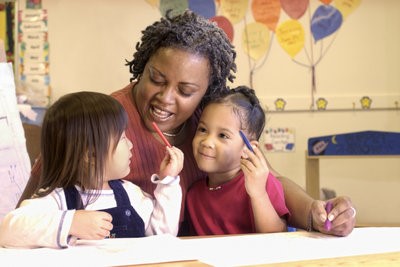My daughter’s love language is words of affection, lots of hugs and cuddles.
However, her brother doesn’t want any of that. What he wants is time. He wants you to spend quality time with him.
Knowing a child’s love language can make a huge difference. It can help strengthen teacher-child bonds, motivate children and reduce unwelcome behaviors.
Everyone experiences love in five main ways – through physical touch, gifts, words of affection, acts of service and quality time. But for everyone, there is usually one or two ways that are most important to them.
Your love language is the one that when used, makes you feel most loved.
So, imagine giving gifts to a child whose love language is words of affection and physical touch.
Here are the 5 love languages and how to use them in the classroom:
1. Words of Affection
If a child always beams with smiles or gets excited when you praise her, then her love language is words of affection. Compliment her regularly such as saying, “Good job, keep it up”, “You look nice today”, “Your handwriting is nice”, “I was proud of your work today”.
2. Quality Time:
A child who always calls for your attention in class and comes to see you regularly has the love language of quality time.. Treat them as individuals, look for opportunities to call them aside and talk to them.
3. Physical-Contact:
Several children like physical contacts, such as a high five, a hug or a pat on the shoulder. There are several types of physical contact that teachers should not do depending on the culture, student gender, and age. It is important to ensure all physical contact with children is appropriate.
4. Acts of Service
As teachers, we do things for our children that they can’t do for themselves and it is important that increasingly we teach them how to do things for themselves. The acts of service love language is when a child appreciates you doing things for them. For example, helping them find a lost item, helping them learn something new, helping them do their homework, etc. However, children must learn self-reliance so don’t jump at every request to do something for them.
5. Receiving Gifts:
For some children, their love language is receiving things. These children see gifts as a symbol of love. However, as teachers, we need to resist the temptation to shower children with gifts and presents. The gifts given must be more thoughtful than expensive. For instance, giving a card, a lollipop, a story book.
Each teacher needs to identify the love language of the children in their class by paying attention to how the child expresses love to others, what the child complains about frequently or what love language they frequently choose when given an option.
Subscribe to 9ijakids blog for more interesting articles. Click Here

Download the 9ijakids app today to get access to 10 FREE educational games for 30 days.
Limited time offer.
Don’t miss out!!!


